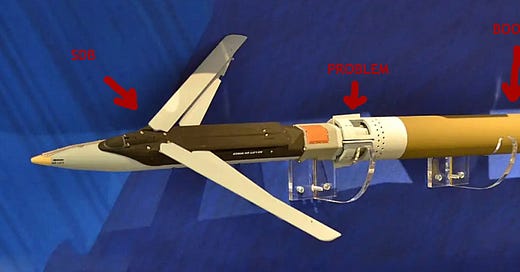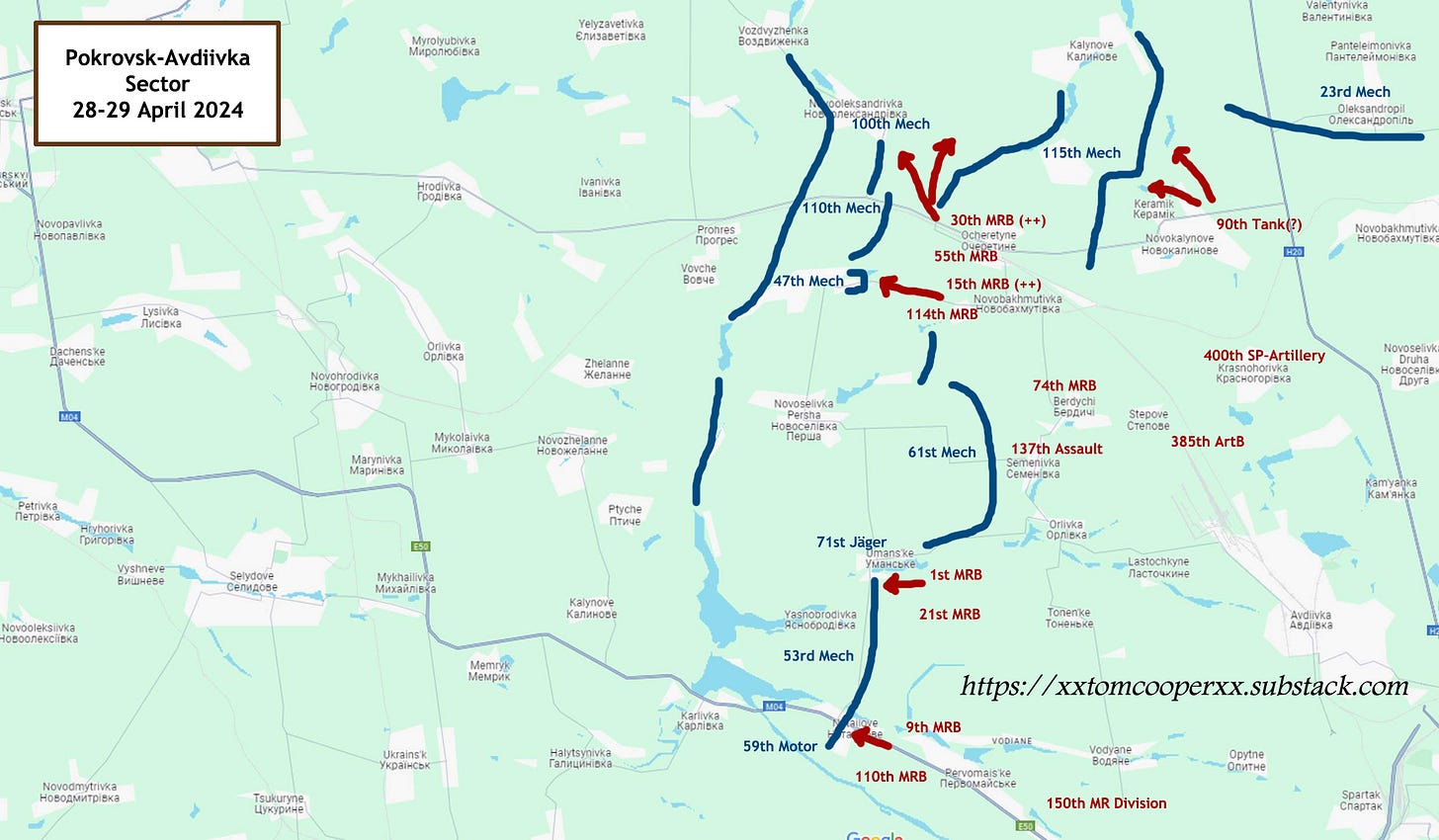Hello everybody!
Another short update for today, focusing on the situation in Pokrovsk-Avdiivka sector.
Ah yes, before I go on with that topic: one correction. Back on 27 April, I’ve mentioned the Russians jamming the GPS guidance of the GLMRS and the ZSU thus withdrawing this weapon from operational service. As it turned out the actual problem is with the GLSDB.
That is the ground-launched small diameter bomb (SDB, also known as the GBU-39). And then, so say contacts, the problem is not with the Russian jamming of the GPS, but with the system responsible to disconnect the GBU-39 SDB from the booster, once the weapon is launched and airborne.
What’s that?
The booster serves the purpose of launching the weapon, getting it airborne and to its trajectory to the target. The booster burns for few seconds: that’s enough to get the weapon to its speed and trajectory. Once the booster burns out, it’s ‘spent’, disconnected from the weapon and falling away in order not to spoil the weapon’s performance. Lately, GLSDBs began suffering a mechanical failure in which the booster section failed to separate, as result of which all too many GBU-39s were missing their target. Thus, and to prevent unnecessary waste of expensive weapons, the ZSU has withdrawn the GBU-39 SDBs from use (until the manufacturer solves the problem).
(Thanks for info!)
Must admit: I’m relieved to hear that, because if the Russians could effectively jam the GPS-guidance of such weapons… oh dear…
Why that?
Because nowadays, GPS is related to- and thus influencing ‘almost everything’ Western armed forces are doing, and thus the ZSU is doing, too. That is not only guided weapons, but also navigation on the ground, plus such automated tactical management systems like the ZSU’s Kropyva. I.e. if the Russians could jam the GPS, they would wreak havoc with the coordination of Ukrainian units, too.
….shouldn’t mean the Russians aren’t going to keep on trying (indeed: continuing to do their best) in this regards.
BATTLE OF DONBAS
It’s ironic: back in February this year, shortly after the fall of Avdiivka, we’ve heard a lots of complaints in the social media, all in style of, ‘ZSU has no defence lines west of Avdiivka’. Didn’t buy that because contacts were zip-lip in this regards. Well, it turns out it the ZSU has ‘them’: constructed defence lines. And not just one, but some 3-4 (at least).
Problem?
Well, there is not just one problem…
1.) Most of new fortifications of these defence lines were constructed to defend from an attack from the EAST. I.e. they have been constructed in North-South direction.
2.) Some were incomplete and thus there were (and, probably: still are) few ‘gaps’ in between them. Usually, these would be covered by minefields. However, there is a lack of mines (so much so the ZSU hasn’t got enough mines even if using dozens of thousands of Russian mines recovered from Kherson and eastern Kharkiv, just for example). And,
3.) There are sectors that are hard to mine – like railway berms.
These are two ‘primary reasons’ why the Russians broke through in the Ocheretyne area. Firstly, they are now searching for such non-mined gaps in ZSU’s defence lines, and, secondly, when they find them they’re trying to advance in northern direction, ‘parallel’ to the Ukrainian defence lines; thus into the flank or the back of ZSU’s defence lines – in turn forcing Ukrainians to withdraw.
We’ve seen them doing this (with success) in the Novokalynove area, some 4-5 days ago: Instead of frontally assaulting local positions of the 115th, though while pinning down the 115th by artillery and air strikes, the Russians have advanced in northern direction until finding a way to outflank that position. Result: the 115th had to fall back to Arhanhelske without much fighting for Novokalynove and Keramik.
Another example can be seen west of Ocheretyne area. There, the Russians did frontally attack the first ZSU defence line, and even managed to force Ukrainians to withdraw. However, once they were through, they did not continue in western direction: they’ve turned north in direction of Novooleksandrivka and are ‘currently’ (see: last 24-36 hours) trying to outflank the ZSU defence line running from the south up to that village, ‘but not really covering Novooleksandrivka’.
In turn, this also means: once the 100th Mech was deployed in the Novooleksandrivka area, it couldn’t just enter existing field fortifications, constructed in advance, but also had to construct new fortifications connecting those running in North-South direction with each other. Doing that while subjected to air strikes and artillery barrages is ‘anything else than easy’ (though also dispelling another myth spread in the social media, according to which the ZSU is ‘lazy’ when it comes to digging trenches).
Talking about mythology… without going into too many details, let me just observe that the last few days the ZSU has rotated several of units out of this sector – and replaced them with ‘fresh’ units, and that without any ‘special’ problems or losses of positions. I find this ‘good’ for multiple reasons.
1.) It means the ZSU still has reserves (which is always good);
2.) it means the internal security of the Tavriya OSG is good (of course, one can never get complacent about this issue);
3.) it means the commander of the Tavriya OSG (and his staff) are in control of the situation and confident they can make it;
4.) it also means the units that moved in, are at least as good as those they have replaced; and,
5.) the units rotated out of the line are all in need of (well-deserved) rest.
Oh, and a big plea: please, do not consider any of my maps for something like ‘gospel’: they’re ‘approximate’. I’m not even trying to draw precise flow of ZSU’s defence lines, for example. ‘Approximate’ will make do: it’s ‘enough for public consumption’. Moreover, mind that units are moved around the battlefield most of the time.






The manufacturer responsible for the GLSDB's separation mechanism couldn't possibly be Boeing, could it?
Thank you very much. Thank you for the last paragraphs which are close to something like"good" news at last from this part of the front.